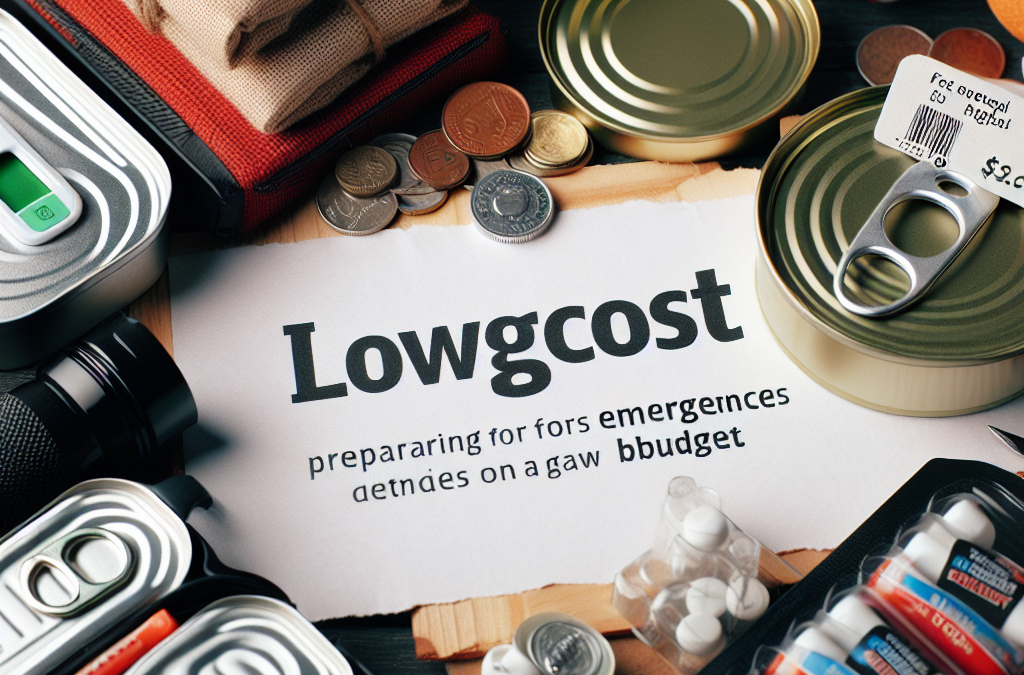Understand Your Needs
Assess Possible Emergencies
When I started thinking about preparing for emergencies, the first thing I did was take stock of what kinds of emergencies could happen in my area. I made a list of potential scenarios: natural disasters, power outages, or even job loss. This helped me focus my efforts where they were needed most.
It’s key to tailor your preparations to your specific situation. For instance, if you live in a flood-prone area, you might need more emphasis on water safety supplies. On the other hand, if you’re in a region that frequently faces wildfires, having a plan for evacuation and supplies to sustain you in that event becomes crucial.
Always keep in mind that preparedness isn’t one-size-fits-all. By understanding your unique risks, you’ll be better positioned to allocate your limited budget effectively, ensuring that you don’t waste resources on things you don’t actually need.
Start with Essentials
Create Your Emergency Kit
An emergency kit can sound intimidating, but it doesn’t have to break the bank. I started with the basics: water, non-perishable food, a flashlight, and a first aid kit. Sometimes, the simplest things can make a big difference when things go haywire.
One neat trick I discovered was to look for deals on emergency supplies at discount stores or during sales. I often found bulk water bottles or canned goods that were nearing their expiration date but still perfectly good to use. That way, I stock up without feeling the pinch on my wallet.
Over time, I’ve added personal items—medications or special foods for family members with dietary needs. Always remember, personalization is key, and these items can truly elevate your emergency preparedness.
Thank you for reading this post, don't forget to subscribe NOW for FREE!
Budget-Friendly Methods
DIY Solutions
Who said prepping needs to cost an arm and a leg? I’ve found that many times, a little creativity can go a long way. For example, I made my own water filtration system using a clean, empty plastic bottle and sand. It’s not only cost-effective but also a fun little project!
YouTube has been my go-to for DIY projects, with step-by-step videos guiding me through everything from building a solar oven to creating a makeshift stove. It’s a great way to learn, and honestly, I feel a sense of accomplishment each time I finish a project.
Never underestimate the power of community too. Local groups often share resources, swap supplies, and offer workshops on various skills. This has not only saved me money but has also helped me develop a sense of solidarity with others in my community.
Stay Informed and Flexible
Utilize Reliable Resources
Being prepared goes beyond just having supplies; it’s about knowledge too. I started following reliable websites and blogs dedicated to emergency preparedness. Their tips are gold and often free to access!
I also enrolled in some local workshops. Many times these are offered at a low cost or even for free. From basic first aid to survival skills, I learned a ton and felt more equipped to handle unexpected situations. Plus, I got to meet others who shared my interest!
Flexibility is also key in this journey. What works one year might not be relevant the next, so I always stay open to updating my knowledge and adapt my plans accordingly. Life is unpredictable—being ready means staying on my toes.
Connect and Share Your Knowledge
Community Engagement
Engaging with my community made a world of difference. I started small by sharing what I learned with friends and family. It’s incredible how much you can empower others by simply sharing your experiences and knowledge.
I’ve also joined local forums and social media groups where folks discuss their prepping strategies. It’s a two-way street; you share your techniques, and others share theirs. It creates a wealth of ideas that cost nothing but can have real, tangible benefits.
Don’t forget about volunteering! Getting involved in local emergency response teams or community service groups can help you gain firsthand knowledge about logistics and planning. Plus, these activities often come at little to no cost and are great for networking too.
FAQ
1. What should be included in my emergency kit?
Your emergency kit should include water, non-perishable food, a flashlight, batteries, a first aid kit, and any personal items like medications or important documents.
2. How can I find local workshops on emergency preparedness?
Check community centers, local libraries, or social media for announcements. Websites of local emergency management departments often list workshops as well.
3. Are there any free resources for emergency preparedness?
Absolutely! Websites like FEMA, local health departments, and community groups often provide free educational materials and planning guides.
4. How often should I update my emergency kit?
It’s a good idea to review and update your emergency kit at least once a year, or whenever there’s a change in your family’s needs or local risks.
5. Can I really prepare effectively on a small budget?
Yes! With careful planning, creativity, and resourcefulness, you can build a solid emergency preparedness plan without spending a lot of money.






